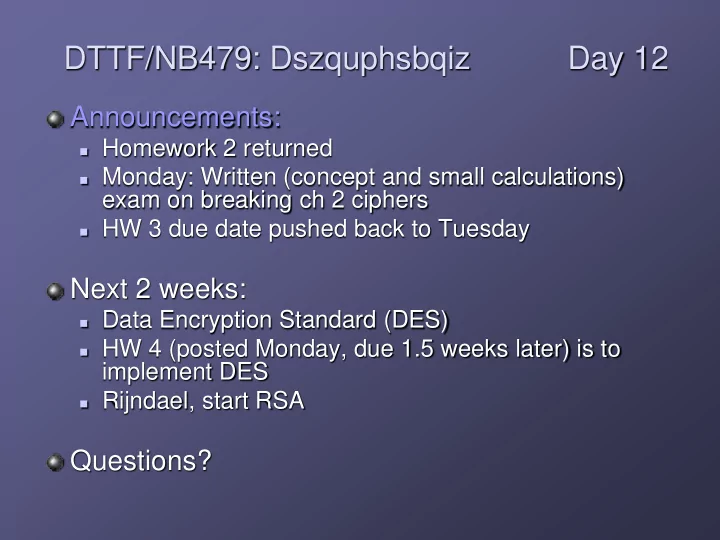

DTTF/NB479: Dszquphsbqiz Day 12 Announcements: Homework 2 returned Monday: Written (concept and small calculations) exam on breaking ch 2 ciphers HW 3 due date pushed back to Tuesday Next 2 weeks: Data Encryption Standard (DES) HW 4 (posted Monday, due 1.5 weeks later) is to implement DES Rijndael, start RSA Questions?
The Chapter 2 Written Exam is next class Content: Written problems Concepts of the algorithms we discussed, how they work, how you can break them using various attacks Inverses of integers and matrices (mod n) Working out some examples by hand, like 5 -1 mod (7) Anything else from ch 1-2, but nothing that will require a computer. Rules: Closed book and computer You may bring a sheet with letters numbers, and inverses mod 26. A scientific calculator is allowed
DES is a block cipher History? Full-scale version operates on 64-bit blocks Text ASCII bit vector Block 1 (64 bits) Block 2 (64 bits) DES DES … Encoded 1 (64 bits) Encoded 2 (64 bits) Encoded bit vector
EDEN is a toy version of DES that operates on 12-bit blocks EDEN is a term I coined: E asy D ata E ncryption N on-standard
EDEN Input (12 bits) The key, K i for round i is derived from a 9-bit L 0 (6) R 0 (6) key K. Repeat for 8 rounds K 1 (8) 1. Write L 1 , R 1 f Round 1 2. We can decrypt by switching L and R and using the same procedure! (We need only to reverse the key L 1 (6) R 1 (6) sequence.) Example. K 2 (8) f Round 2 This is a Feistel system. … L 2 (6) R 2 (6)
1-4 EDEN’s encryption function f has the same three types of components as DES’ f Expanders 1. XOR with key 2. S-boxes 3. Read p. 116 to help with Q1-4. Could you implement this?
DES has the same structure as EDEN except it uses initial permutations (IP) Trappe &Washington, p. 125
The initial permutation table tells at which position in the input to find the output bit 58 50 42 34 26 18 10 2 60 52 44 36 28 20 12 4 62 54 46 38 30 22 14 6 64 56 48 40 32 24 16 8 57 49 41 33 25 17 9 1 59 51 43 35 27 19 11 3 61 53 45 37 29 21 13 5 63 55 47 39 31 23 15 7 Reading permutation tables Say y = IP(x) Then y[1] = x[58], y[2] = x[50], … If y = IP -1 (x), y[58] = x[1], y[50] = x[2], …
Differences between DES & EDEN EDEN DES 12-bit blocks 64-bit blocks Extra initial permutation IP (for efficiency in 1970’s?) 8 rounds 16 rounds E: 6 8 bits E: 32 48 bits 9 bit key: use 8/round 64-bit key: use 56/round Also contains extra permutations, a left-shift each round, and a reduction to 48 bits each round 2 S-boxes: 4 3 bits each 8 S-boxes: 6 4 bits each f ends by permuting the 32 bits
5 T&W, p. 126
DES round keys involve two permutations and a left shift 0 1 1 1 1 1 1 0 0 1 0 0 1 0 0 0 1 1 0 0 0 0 1 0 1 0 0 0 0 0 1 0 K = 0 0 0 1 1 1 0 0 0 0 0 0 1 1 1 0 1 1 1 1 0 1 0 0 1 1 1 0 1 0 0 0 Grab 56 permuted bits:[ 57, 49, 41, 33 …] Get 1100 … In round 1, LS(1), so: 100 … 1 Then grab 48 permuted bits: [14, 17, 11, 24, 1, 5, 3, …] Get … 1 0 … T&W, p. 127
Recommend
More recommend